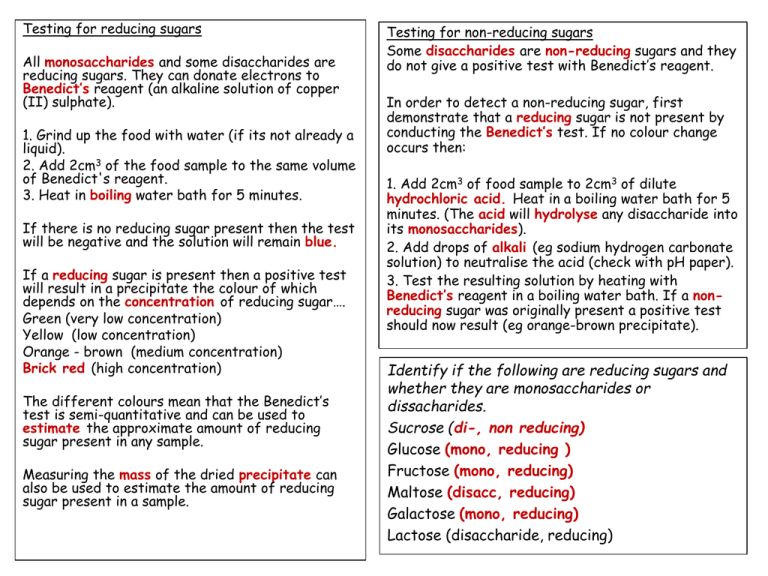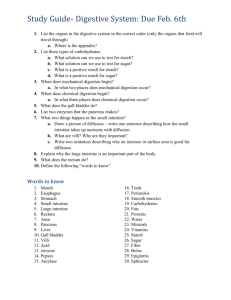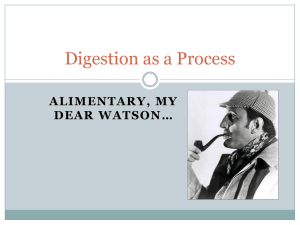File
advertisement

Testing for reducing sugars All monosaccharides and some disaccharides are reducing sugars. They can donate electrons to Benedict’s reagent (an alkaline solution of copper (II) sulphate). 1. Grind up the food with water (if its not already a liquid). 2. Add 2cm3 of the food sample to the same volume of Benedict's reagent. 3. Heat in boiling water bath for 5 minutes. If there is no reducing sugar present then the test will be negative and the solution will remain blue. If a reducing sugar is present then a positive test will result in a precipitate the colour of which depends on the concentration of reducing sugar…. Green (very low concentration) Yellow (low concentration) Orange - brown (medium concentration) Brick red (high concentration) The different colours mean that the Benedict’s test is semi-quantitative and can be used to estimate the approximate amount of reducing sugar present in any sample. Measuring the mass of the dried precipitate can also be used to estimate the amount of reducing sugar present in a sample. Testing for non-reducing sugars Some disaccharides are non-reducing sugars and they do not give a positive test with Benedict’s reagent. In order to detect a non-reducing sugar, first demonstrate that a reducing sugar is not present by conducting the Benedict’s test. If no colour change occurs then: 1. Add 2cm3 of food sample to 2cm3 of dilute hydrochloric acid. Heat in a boiling water bath for 5 minutes. (The acid will hydrolyse any disaccharide into its monosaccharides). 2. Add drops of alkali (eg sodium hydrogen carbonate solution) to neutralise the acid (check with pH paper). 3. Test the resulting solution by heating with Benedict’s reagent in a boiling water bath. If a nonreducing sugar was originally present a positive test should now result (eg orange-brown precipitate). Identify if the following are reducing sugars and whether they are monosaccharides or dissacharides. Sucrose (di-, non reducing) Glucose (mono, reducing ) Fructose (mono, reducing) Maltose (disacc, reducing) Galactose (mono, reducing) Lactose (disaccharide, reducing) Carbohydrate digestion Starch digestion Chewing food creates a larger surface area for salivary amylase (produced by the salivary glands) to work. amylase Starch maltose In the stomach amylase is denatured by the hydrochloric acid, so no further digestion occurs. In the small intestine starch digestion continues with the arrival of pancreatic amylase. It works in neutral pH conditions provided by pancreatic juice and secretions from the wall of the small intestine. Muscles in the wall of the small intestine help to mix the food with enzymes and move it along the gut. The epithelial cells lining the small intestine produce the enzyme maltase.. maltase Maltose 2 α glucose Sucrose digestion The disaccharide sucrose is a natural sugar found in many plant cells. Chewing in the mouth helps to break open the cell walls and release the sucrose. Sucrose is digested by the enzyme sucrase which is made by the epithelial cells lining the small intestine. sucrase Sucrose Glucose + fructose Lactose digestion Lactose is a disaccharide found in milk. It is digested by the enzyme lactase which is produced by the epithelial cells lining the small intestine. lactase Lactose Glucose + galactose Some people do not make enough/any lactase and are lactose intolerant. Any lactose they consume remains undigested and microbes in the large intestine break it down releasing gas. Other symptoms may include nausea and diarrhoea. Absorption of carbohydrates in the small intestine Diffusion As carbohydrates are digested there is usually a high concentration of glucose in the small intestine. The concentration of glucose in the blood is usually low as it is constantly being removed by cells for respiration. In this situation glucose can be absorbed by diffusion into the blood, down its concentration gradient. A favourable concentration gradient for diffusion is maintained by…. 1. The constant circulation of blood removing glucose that has been absorbed into the blood capillaries within the villi of the small intestine. 2. Contraction of muscles in the small intestine mixing of the contents of the gut lumen so that food/glucose comes into contact with the villi ready for digestion/absorption. Absorption of carbohydrates in the small intestine Active transport When the concentration of glucose in the small intestine decreases, further glucose cannot be absorbed by diffusion. However, glucose can also be absorbed by active transport. This mechanism utilises a sodium potassium ion pump. 1. The sodium-potassium ion pump (a carrier protein) uses energy from ATP to move sodium ions out of the villi epithelial cells. 2. Sodium ions are now at a higher concentration in the lumen of the small intestine, than in the epithelial cells. 3. Sodium ions enter the epithelial cells via a carrier protein, moving down their concentration gradient. A molecule of glucose enters with each sodium ion (co-transport occurs). 4. Glucose is removed from the epithelial cells through a protein channel via facilitated diffusion. It then enters the blood.





